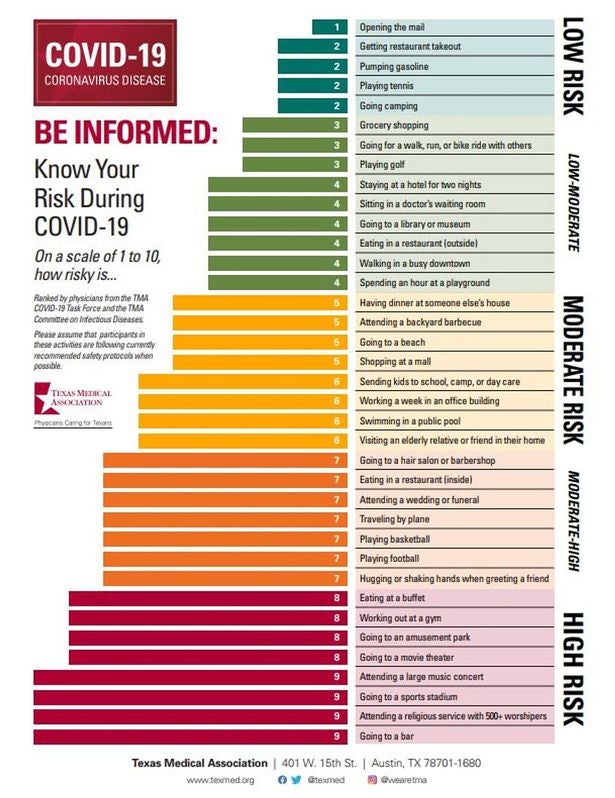Coronavirus: Which everyday activities put you most at risk from Covid-19?
Buying groceries and opening post are considered low risk, according to researchers
Your support helps us to tell the story
From reproductive rights to climate change to Big Tech, The Independent is on the ground when the story is developing. Whether it's investigating the financials of Elon Musk's pro-Trump PAC or producing our latest documentary, 'The A Word', which shines a light on the American women fighting for reproductive rights, we know how important it is to parse out the facts from the messaging.
At such a critical moment in US history, we need reporters on the ground. Your donation allows us to keep sending journalists to speak to both sides of the story.
The Independent is trusted by Americans across the entire political spectrum. And unlike many other quality news outlets, we choose not to lock Americans out of our reporting and analysis with paywalls. We believe quality journalism should be available to everyone, paid for by those who can afford it.
Your support makes all the difference.People across the country have begun returning to pubs, bars, restaurants and hairdressers following the latest easing of lockdown restrictions.
Earlier this month, prime minister Boris Johnson announced that more “non-essential” businesses could reopen in a bid to get the economy moving again, following more than three months of lockdown.
Having taken a huge financial hit as a result of lockdown, business owners welcomed the changes while many relished the opportunity to go out for a drink.
But not everyone is comfortable with the return to “normal life”, particularly those with long-term health conditions. For those who need to take extra care when going out, researchers in the US have devised a list of activities ranked in relation to their risk of catching Covid-19.
“[These activities are] ranked by physicians from the Texas Medical Association (TMA) COVID-19 Task Force and TMA Committee on Infectious Diseases,” medics wrote of the chart.

“Please assume that participants in these activities are following currently recommended safety protocols when possible.”
Researchers ranked a number of activities as low risk, low-moderate risk, moderate risk, moderate-high risk and high risk.
Opening the post and getting a restaurant takeaway were among some of the activities listed in the low risk section, while eating at a buffet, going to a bar and attending events with large crowds were all deemed high risk.
According to the chart, grocery shopping, going for a walk or run, eating outside a restaurant and playing golf are all low-moderate risk activities.
In the UK, official guidance from the NHS remains that people should try to stay at least 2m apart from anyone they don’t live with.
People should wash their hands frequently with hand sanitiser when in public and it is now mandatory to wear a face covering on public transport.
The main symptoms of coronavirus are a high temperature, a new and continuous cough and a loss or change to your sense of smell or taste.
If you experience any of these symptoms you should:
- Stay at home (self-isolate) – do not leave your home or have visitors. Anyone you live with, and anyone in your support bubble, must also self-isolate.
- Get a test – get a test to check if you have coronavirus as soon as possible. Anyone you live with, and anyone in your support bubble, should also get a test if they have symptoms
- Contact NHS 111 if you need further help
Full list of activities below:
Low Risk
Opening the mail
Getting restaurant takeout
Pumping gasoline
Playing tennis
Going camping
Low to moderate risk
Grocery shopping
Going for a walk, run, or bike ride with others
Playing golf
Staying at a hotel for two nights
Sitting in a doctor’s waiting room
Going to a library or museum
Eating in a restaurant (outside)
Walking in a busy downtown
Spending an hour at a playground
Moderate risk
Having dinner at someone else’s house
Attending a backyard barbecue
Going to a beach
Shopping at a mall
Sending kids to school, camp, or day care
Working a week in an office building
Swimming in a public pool
Visiting an elderly relative or friend in their home
Moderate to high risk
Going to a hair salon or barbershop
Eating in a restaurant (inside)
Attending a wedding or funeral
Traveling by plane
Playing basketball
Playing football
Hugging or shaking hands when greeting a friend
High risk
Eating at a buffet
Working out at a gym
Going to an amusement park
Going to a movie theater
Attending a large music concert
Going to a sports stadium
Attending a religious service with 500+ worshipers
Going to a bar

Join our commenting forum
Join thought-provoking conversations, follow other Independent readers and see their replies
Comments